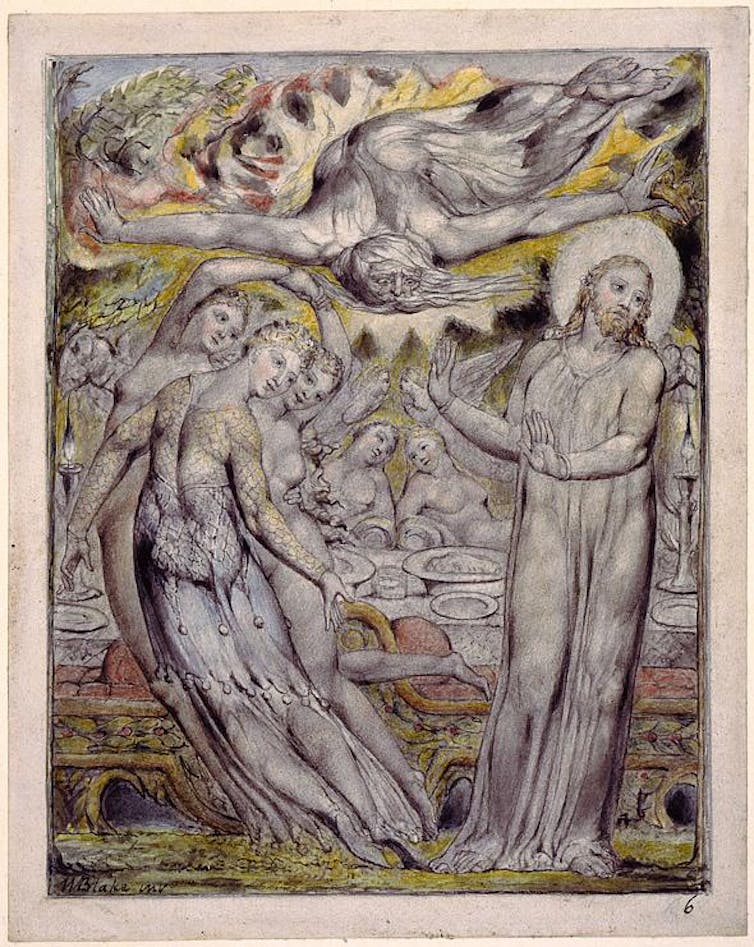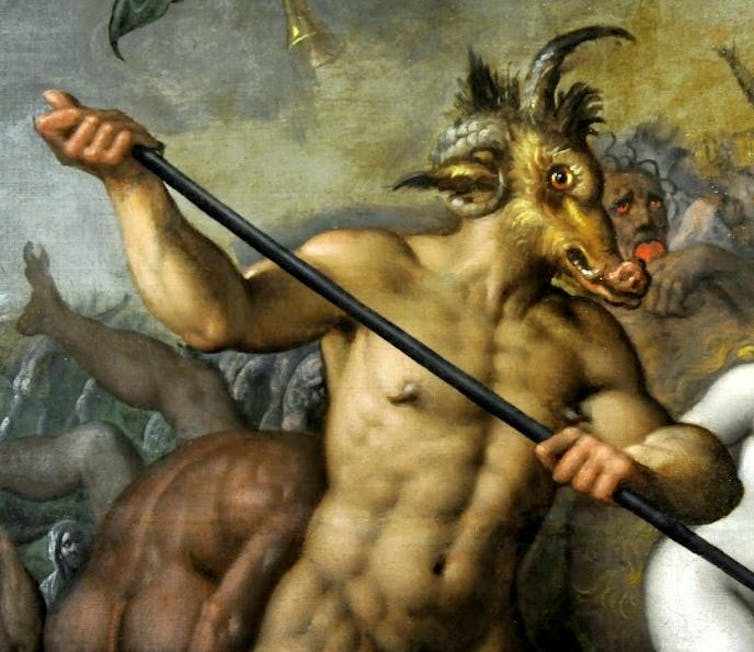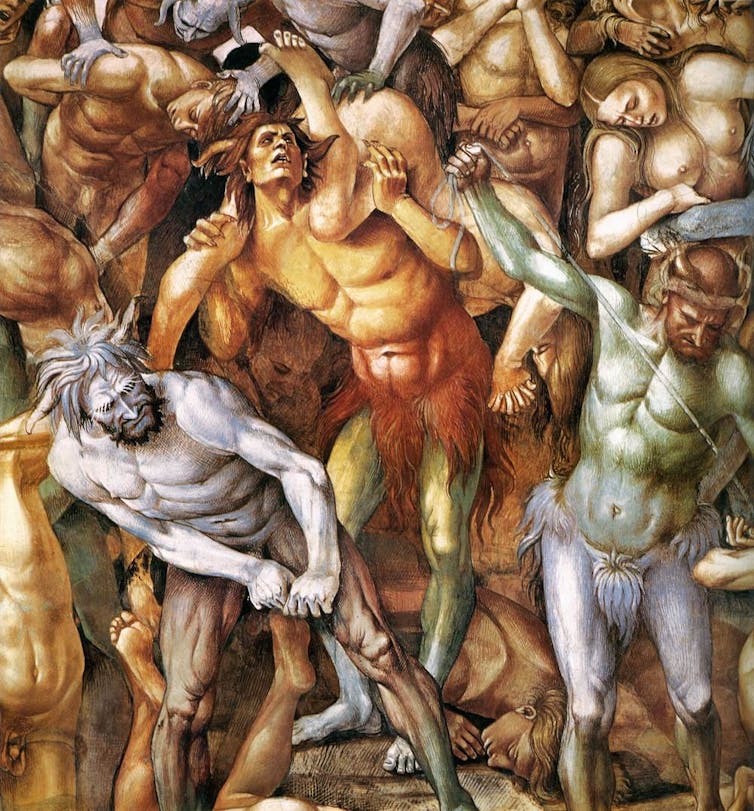Chris Priestman
Published 1 week ago:July 13, 2021
Filed to:AEVEE BEE


Kitty Horrorshow was the first game maker to tell me she was a witch, and it wasn’t a joke. On the contrary, Horrorshow was revealing the spirituality that allowed her horror games, ANATOMY and CHYRZA, to have a sense of mystique and danger.
Horrorshow is one of a growing number of young people who practice witchcraft or identify themselves as a witch. As both VICE and The Guardian outline, witches have especially seen a resurgence among women, trans and queer-identifying people recently. Some of them dress up, some cast spells and do tarot, others create webcomics and video games.
Some see witches as icons of feminist power, or women who challenge the rules and boundaries of society. Cultural historian Rictor Norton writes that witches have always been associated with heresy, and were thought to practise unorthodox activities, such as homosexuality, which “was often an important feature of the witches’ real or alleged initiation rituals”.
Accordingly, game maker Solomon Fletcher finds that “even though the term ‘witch’ is usually tied to womanhood, it’s always felt genderless to [them]”. Witches naturally invite genderqueer discourse, and that’s part of the appeal of adopting the philosophy.
An alternative spirituality

One way to approach witchcraft is to adopt it as a spirituality called Wicca, a Pagan religion derived from pre-Christian beliefs. Wicca’s followers believe in both male and female deities, who teach that natural objects contain magical powers that can be channelled by performing rituals.
Horrorshow developed her interest in witchcraft as a way to escape the “super intolerant” upper-middle-class suburb she grew up in. She claims the people there were apprehensive toward anything that didn’t fall into their purview. That led to Horrorshow repressing her trans identity and feeling bad for even having thoughts of living in a different body. But when Horrorshow started reading books about the supernatural effects of burning different colour candles, she found a spirituality that spoke to her in ways her physical environment discouraged.
For Horrorshow, rituals are the gateway to a realm between the conscious and unconscious, where she pulls on invisible energies to create her art. “Sometimes it involves lighting candles and laying out paper and brushing ink across it into patterns that don’t make sense until later,” Horrorshow says. “Sometimes it involves waking myself up prematurely and pouring half-formed words out into a spiral notebook without being able to see what I’m writing.”

At other times, her witchcraft involves writing poems, songs, or making video games. Whatever the medium, Horrorshow’s creations are coloured by her personal experience as a practising witch. Ritual, for example, is a semi-autobiographical game that follows an individual who despises their body so much that they perform a magical ritual to change it. At first, the body becomes powerful, resembling the “goddess of witches”, but then violently disintegrates into nothing. It’s a game that reflects the agony of living in a body that society shuns and the impossible wish for something magical to change that.
Another obvious analogue is Rain, House, Eternity, which has you make a big, personal, choice at an altar. Its narrative speaks to the unfair pressures society puts on our bodies, gendered or otherwise. The choice at the altar is to give up and commit suicide or to become powerful through transition — to change the body through witchcraft. Sigils are also featured throughout the game, which Horrorshow says “comes from a place of personal practice”.

Witchcraft in this context is a “counter spirituality to the religious conservatism that defined many [queer people’s] childhoods,” as game developer Aevee Bee puts it. The visual novel Bee co-created, We Know The Devil, explores what it means to embrace witchcraft through three queer teens who attend a Christian summer camp, where they spend a night in the woods awaiting the devil. “What [the protagonists] encounter in the woods they understand and perceive as the devil because that is what they have been taught to understand their desires, identity, and love as,” Bee says. By embracing the devil, the protagonists find liberation from their religious upbringings, just as someone might by realising it’s acceptable to be queer.
The rise of witchcraft as a spirituality these past few years serves the same function Marilyn Manson did in the ’90s. It’s a way for young people who fall out of mainstream society to find something that speaks to them and accepts them. Specifically, as both Marilyn Manson and witchcraft involve satanic ritual, those drawn to them are likely rebels against religious upbringings. Witchcraft lets them hold on to the comforts of having a spirituality but in a way that serves them rather than shuns them.
Sisters doing it for themselves

Given that witches have been an icon of sisterhood for many years, their most obvious draw is in empowering and bringing women together. From the 15th century to the 18th century, across Europe and America, the witch craze saw women who were disliked or misunderstood by society hunted down and killed by the thousands.
For Arielle Grimes, there are parallels between those persecuted witches and the lives of queer women today. In 2013, the National Coalition of Anti-Violence Program found 72 per cent of hate violence homicides in New York were against transgender women, and that number has since increased. Grimes made a game called 2sWitches, which follows two witches who use the power of sex to open a portal to a safer world. “2sWitches is about rebuilding oneself through shared intimacy with others,” Grimes says. “I found that this resonated strongly with many of my friends and the greater community of queer women processing their identity post-trauma.”
Included in that community are women like Jillian Wakarchuk, the co-creator of the game Crystal Witch Cyber Jamz. For her, witches symbolise fear, and the ugliness of that fear can be reclaimed by exiled women and marginalised people. “There is a lot of power in being feared, in having knowledge, and in having control,” Wakarchuk says. “When women and queer folks have this power, it goes against the patriarchal system of power, which can be a satisfying and cathartic new dynamic.”Witches symbolise fear, and the ugliness of that fear can be reclaimed by exiled women and marginalised people.
This is played out in Crystal Witch Cyber Jamz, in which you are a magical musician trying to reclaim items that have been stolen by a male-dominated technopagan cult. It was made to “explore the power in screaming and being ugly to tear a structure down,” Wakarchuk says. The game is informed by and subverts classic images of crones and the medical history of “female hysteria” diagnoses. For centuries, both of these allowed men to destroy the lives of women: The former forced women to conform to beauty standards, while the latter punished women who simply expressed emotion.

But not all modern witches find power in the monstrous femme. Jennifer Raye, the co-creator of Witchrider Nova, finds her power in colourful cartoon witches. Raye grew up with masculine pressures that denied enjoyment of magical girls; the frilly-dressed heroines of manga and anime who deal with everyday life while possessing supernatural powers. But as Raye began to question her identity as she grew up, she found solace in anime like Sailor Moon and games like Touhou and Cotton. “They represent something I was once afraid to enjoy, and discouraged from, but now I’m free as an adult to do so,” Raye says. She describes Witchrider Nova as “a game for 14-year-old Jenn… something unabashedly feminine, without being exclusive.”
In both cases, whether the witches are ugly or cute, women are reclaiming images that have been used to scorn them in the past. It’s a way of taking power from oppressors and turning it back on them.
Witches as healers

While many witches were believed to kill livestock and poison village waters, another type of witch was essentially a female healer. Proof of this is seen in the witch trial of Jacoba Felicie in 1322, whose accusation read, “she would cure her patient of internal illness… visit the sick assiduously and continue to examine… in the manner of physicians.” As practising medicine was considered a male profession at the time, when a woman healed people, it was a crime punishable by death.
Gabriela Aveiro-Ojeda is a developer who is inspired by her Paraguayan heritage, allowing her to make games with brujas (the Spanish for witch). Brujas are a type of witch-healer that emerged from Hispanic and Native American cultures, and they are seen as people who have been assigned black magic by the gods. Also associated with witches in these regions are the curanderos, who are medicine men that use herbalism and folk remedies to heal people.

While brujas and brujeria have been feared by some, in some cultures they command respect. This is why Aveiro-Ojeda depicts them as healers and protectors who use witchcraft against oppression and to maintain cultural identity.
“Growing up Paraguayan and later as part of the latinx diaspora, brujeria is part of my life,” Aveiro-Ojeda says. “In Paraguay we have some ritualistic practices that are the result of our mestizo culture, such as beliefs about divining the future or protecting one’s home, so to me it’s very important to have depictions of this brujeria that center latinx women (in particular indigenous and afro-latinas) as a way to dispel superstitions around witchcraft and use it for healing and resistance.”
AP Thomson is another game developer who uses witchcraft as a medium for healing, specifically as a coping mechanism for mental health and gender identity. “At one point, I decided to try doing some tarot readings,” Thomson says. “I found it was actually a pretty good way to center my thoughts, re-contextualize what I was struggling with, and give my anxieties a broader perspective.”

Thomson got the idea for their new game, Fortune-500, from a funny website used to interpret tarot readings. The website reads the cards and presents the outcomes as potential futures for the participant, some of which are “performance reviews”, “home improvement”, and “career advancement”. Thomson came up with a term for this bizarre mix of the corporate world and witch culture: “White collar witchcraft”, and that aesthetic is prominent in Fortune-500.
Fortune-500 has you play as a fortune-telling witch who works for the “Magical Resources” department in a large corporation. The witch has anxiety, and believes that people secretly hate them, or that their work is worthless despite evidence to the contrary. “She’s close to being fired because her co-workers don’t understand what she actually does when compared with the much more obvious elemental magic of her wizard co-workers,” says Thomson. Fortune-500 takes anxieties and lays them out in a format that people can interact with, and hopefully make sense of them.By appropriating images and terms used to scorn and kill women, they can find power, community and inspiration for marginalised people.
Thomson’s aim, along with those of other witch game developers, is reclamation. By appropriating images and terms used to scorn and kill women, they can find power, community and inspiration for marginalised people. The importance of doing this in today’s climate is something Thomson understands well: “Wizards in popular media are often portrayed as wise advisors and mentors who are instrumental in the rise of powerful men (think Merlin and Gandalf). Meanwhile, witches in popular media are often portrayed as being instrumental in the downfall of powerful men (think Macbeth and The Little Mermaid). Given recent events in the world, it’s hopefully more and more obvious why the downfall of powerful men is often necessary and just. Basically, the world needs witches.”












 Image:Empty shelves have been spotted in recent days as many workers have been forced into self-isolation after being pinged by the app
Image:Empty shelves have been spotted in recent days as many workers have been forced into self-isolation after being pinged by the app

